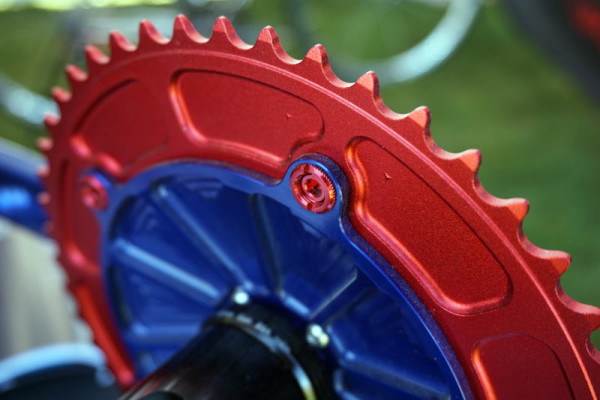Ridea was started in Taiwan, grew into Singapore and China, then Australia, and finally parts of Europe. Now, they’ve been infiltrating the U.S. for about a year and a half with their duo-oval Powerings, a unique take on ovalized chainrings that have four different levels of ovalization and options for virtually any crankset on the market.
Everything is fully CNC’d, like the Captain America inspired time trial crankset used to draw our eye to the booth. Yes, that one’s a regular round chainring, but it’s hiding another clever little part on its backside.
Here’s how it works…
Imagine two overlapping ovals, represented by the dotted lines in this graphic, and you get the idea. Where Rotor is a regular oval and O-Symmetric is a double cam, they use a dual ovalized design to clock different effective gearing based on where your different muscle groups are strongest.
The goal is to maximize the use of your strong quads and glutes (and help make them strong) and minimize reliance on weaker muscles. Whether or not that exacerbates the imbalances cyclists are already prone to remains to be seen, but they do say it’ll make you faster. (Cross training is never a bad idea anyway, don’tcha know)
Ridea akes four different levels of ovalization, using the W1, W2, W3 and W4 designations to describe the effective increase in tooth count during the power phase. For example, the W4 52-tooth ring has an effective spread of eight teeth – the power stroke would be equivalent to a 56, and a 48 on your dead spot. In other words, a W4 has a +/- 4 tooth count effective range.
Different bolt patterns for most common cranks are available, and they’re working on versions for the newest Campy and FSA. They already have the new SRAM 22 and Shimano asymmetric 4-bolt cranks.
In fact, they came out with the four-arm cranks at almost exactly the same time as Shimano, and that let them offer W3 and W4 versions of their double chainrings. With the 5-bolt chainrings, they couldn’t get the combo to work with a tooth difference greater than their W2 offerings.
Power output is claimed to improve by 7%, 10%, 15% and 20% as you climb the tooth offset ladder, and the higher offset models are recommended for more experienced, stronger riders.
For MTB, they have it for all common BCDs for their 1x chainrings: 76, 80, 88, 94, 104, 120 as well as the asymmetric SRAM and Shimano MTB cranks. There are also double and triple chainring groups.
Their narrow/wide design uses a unique short/tall tooth profile, too, to further enhance the chain retention.
Retail is $125 for MTB, $230 to $325 for the road doubles. Those plain round chainrings are just $100. As eye catching as the red and red/white/blue rings are, the black chainrings are ceramic grade hard anodized, which means they’re both smoother and tougher…those are the ones you want. Everything’s tested with their pro riders first, then released to the market.
Ridea also makes brake calipers and a few other items like front derailleur mount spacers to ensure proper cage clearance with the higher offset chainrings…and some exquisitely machined pulley wheels.
The dual pivot design adds power to the lightweight package. Unfortunately, I didn’t get more info on these at the show and they’re not listed on their website yet.
Few parts on the bike can be as annoying to install or remove as the nuts on the back of chainring bolts. Even with the right tools, they’re sometimes finicky or it’s hard to hold the crankarm steady while also holding a small tool in each hand. Ridea’s solution is a nut with a knurled backside that bites into the ring slightly as it’s hand tightened, allowing you to snug the bolt with just the allen wrench from the front without the nut slipping and spinning. Brilliant!








